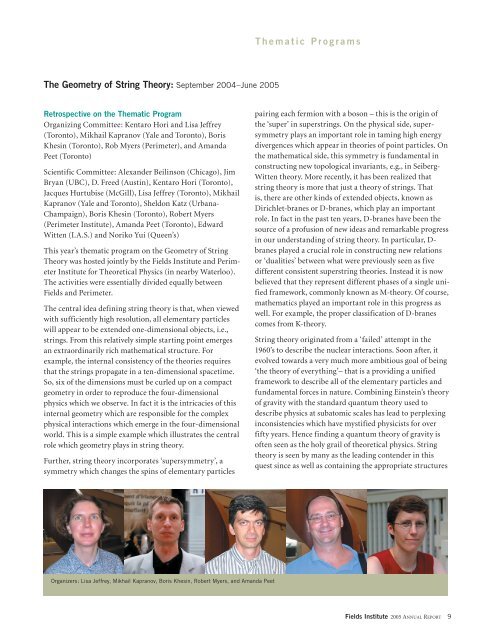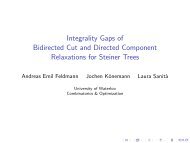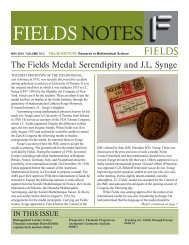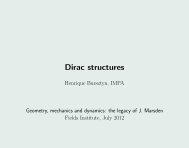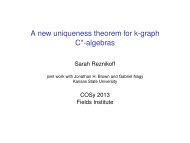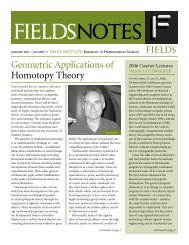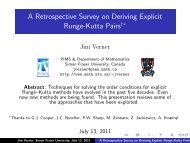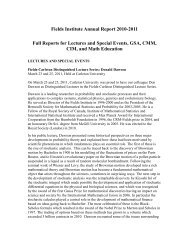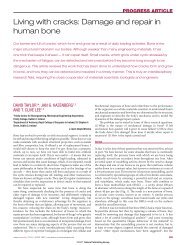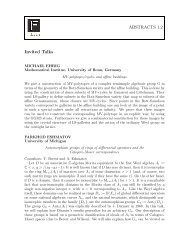Annual Report 2005 - Fields Institute - University of Toronto
Annual Report 2005 - Fields Institute - University of Toronto
Annual Report 2005 - Fields Institute - University of Toronto
Create successful ePaper yourself
Turn your PDF publications into a flip-book with our unique Google optimized e-Paper software.
The Geometry <strong>of</strong> String Theory: September 2004–June <strong>2005</strong><br />
Retrospective on the Thematic Program<br />
Organizing Committee: Kentaro Hori and Lisa Jeffrey<br />
(<strong>Toronto</strong>), Mikhail Kapranov (Yale and <strong>Toronto</strong>), Boris<br />
Khesin (<strong>Toronto</strong>), Rob Myers (Perimeter), and Amanda<br />
Peet (<strong>Toronto</strong>)<br />
Scientific Committee: Alexander Beilinson (Chicago), Jim<br />
Bryan (UBC), D. Freed (Austin), Kentaro Hori (<strong>Toronto</strong>),<br />
Jacques Hurtubise (McGill), Lisa Jeffrey (<strong>Toronto</strong>), Mikhail<br />
Kapranov (Yale and <strong>Toronto</strong>), Sheldon Katz (Urbana-<br />
Champaign), Boris Khesin (<strong>Toronto</strong>), Robert Myers<br />
(Perimeter <strong>Institute</strong>), Amanda Peet (<strong>Toronto</strong>), Edward<br />
Witten (I.A.S.) and Noriko Yui (Queen’s)<br />
This year’s thematic program on the Geometry <strong>of</strong> String<br />
Theory was hosted jointly by the <strong>Fields</strong> <strong>Institute</strong> and Perimeter<br />
<strong>Institute</strong> for Theoretical Physics (in nearby Waterloo).<br />
The activities were essentially divided equally between<br />
<strong>Fields</strong> and Perimeter.<br />
The central idea defining string theory is that, when viewed<br />
with sufficiently high resolution, all elementary particles<br />
will appear to be extended one-dimensional objects, i.e.,<br />
strings. From this relatively simple starting point emerges<br />
an extraordinarily rich mathematical structure. For<br />
example, the internal consistency <strong>of</strong> the theories requires<br />
that the strings propagate in a ten-dimensional spacetime.<br />
So, six <strong>of</strong> the dimensions must be curled up on a compact<br />
geometry in order to reproduce the four-dimensional<br />
physics which we observe. In fact it is the intricacies <strong>of</strong> this<br />
internal geometry which are responsible for the complex<br />
physical interactions which emerge in the four-dimensional<br />
world. This is a simple example which illustrates the central<br />
role which geometry plays in string theory.<br />
Further, string theory incorporates ‘supersymmetry’, a<br />
symmetry which changes the spins <strong>of</strong> elementary particles<br />
Organizers: Lisa Jeffrey, Mikhail Kapranov, Boris Khesin, Robert Myers, and Amanda Peet<br />
T h e m a t i c P r o g r a m s<br />
pairing each fermion with a boson – this is the origin <strong>of</strong><br />
the ‘super’ in superstrings. On the physical side, supersymmetry<br />
plays an important role in taming high energy<br />
divergences which appear in theories <strong>of</strong> point particles. On<br />
the mathematical side, this symmetry is fundamental in<br />
constructing new topological invariants, e.g., in Seiberg-<br />
Witten theory. More recently, it has been realized that<br />
string theory is more that just a theory <strong>of</strong> strings. That<br />
is, there are other kinds <strong>of</strong> extended objects, known as<br />
Dirichlet-branes or D-branes, which play an important<br />
role. In fact in the past ten years, D-branes have been the<br />
source <strong>of</strong> a pr<strong>of</strong>usion <strong>of</strong> new ideas and remarkable progress<br />
in our understanding <strong>of</strong> string theory. In particular, Dbranes<br />
played a crucial role in constructing new relations<br />
or ‘dualities’ between what were previously seen as five<br />
different consistent superstring theories. Instead it is now<br />
believed that they represent different phases <strong>of</strong> a single unified<br />
framework, commonly known as M-theory. Of course,<br />
mathematics played an important role in this progress as<br />
well. For example, the proper classification <strong>of</strong> D-branes<br />
comes from K-theory.<br />
String theory originated from a ‘failed’ attempt in the<br />
1960’s to describe the nuclear interactions. Soon after, it<br />
evolved towards a very much more ambitious goal <strong>of</strong> being<br />
‘the theory <strong>of</strong> everything’– that is a providing a unified<br />
framework to describe all <strong>of</strong> the elementary particles and<br />
fundamental forces in nature. Combining Einstein’s theory<br />
<strong>of</strong> gravity with the standard quantum theory used to<br />
describe physics at subatomic scales has lead to perplexing<br />
inconsistencies which have mystified physicists for over<br />
fifty years. Hence finding a quantum theory <strong>of</strong> gravity is<br />
<strong>of</strong>ten seen as the holy grail <strong>of</strong> theoretical physics. String<br />
theory is seen by many as the leading contender in this<br />
quest since as well as containing the appropriate structures<br />
<strong>Fields</strong> <strong>Institute</strong> <strong>2005</strong> ANNUAL REPORT 9


